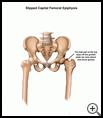
Slipped Growth Plate in Hip (Slipped Capital Femoral Epiphysis)
________________________________________________________________________
KEY POINTS
- Slipped capital femoral epiphysis is when the ball of the hip joint slips off the growth plate where new bone grows.
- Usually this problem is treated with surgery. After surgery your child will need to use crutches for many weeks. Your child may need to limit some sports and other activities until your child is done growing.
________________________________________________________________________
What is slipped capital femoral epiphysis?
Slipped capital femoral epiphysis (SCFE) is a bone problem that affects the hip joint. The hip joint is a ball and socket joint. The socket is part of the hip bone. The ball part of the joint is the top end of the thighbone. Just below the ball part is an area where new bone grows. This is called a growth plate or epiphysis. When a child has SCFE, the ball slips off the growth plate.
This problem may happen in one or both hips. It is common in teens and more common in boys than in girls. It’s also more common in children who are very overweight.
If SCFE is not treated, the end of the thighbone may be destroyed by a lack of blood flow or your child may permanently lose full movement of the hip joint.
What is the cause?
The thighbone grows from an area called a growth plate, just below the ball of the thighbone. Weakness in the growth plate causes the ball to slowly slip off the growth plate. The exact cause of the weakness in the growth plate is not known. It usually happens when your child’s bones are growing quickly during the early teens. A fall or an accident may cause the ball to slip suddenly.
What are the symptoms?
Symptoms may include:
- Hip, leg, or knee pain that lasts for weeks or months
- Limping or trouble putting weight on the leg
- One leg that looks shorter or is turned out more than the other leg
- Problems moving the leg at the hip joint
How is it diagnosed?
Your healthcare provider will ask about your child's symptoms and medical history and examine your child. Your healthcare provider will watch your child walk and move the hip. The provider will check to see if:
- Your child can turn the hip inward.
- Your child can lift the knee and hip toward the chest.
- Your child has extreme pain when moving the hip and knee.
Tests may include:
- X-rays
- CT scan, which uses X-rays and a computer to show detailed pictures of the bones
- MRI, which uses a strong magnetic field and radio waves to show detailed pictures of the bones
How is it treated?
It is important to diagnose and treat SCFE early. Usually it is treated with surgery. There are different ways the surgery may be done. Screws may be used to hold the bones in place as your child grows, or part of the growth plate may be removed.
After surgery your child will need to use crutches for many weeks. Your child will have regular checkups for the next year or two. Your child’s healthcare provider will take X-rays to watch the growth plate. Your child may need to limit some sports and other activities until your child is done growing.
How can I help take care of my child?
Follow the instructions your healthcare provider gives you.
To help treat this condition:
- Follow your provider’s instructions for doing exercises to help your child recover.
- Give nonprescription pain medicine as directed by your provider.
Ask your healthcare provider:
- If there are activities your child should avoid and when your child can return to normal activities
- How to take care of your child at home
- What symptoms or problems you should watch for and what to do if your child has them
Make sure you know when your child should come back for a checkup.
How can I help prevent SCFE
In many cases SCFE cannot be prevented. However, many children with SCFE are also overweight. The extra weight puts more stress on the growth plate in the thighbone at the hip. Losing weight may help relieve some of the pressure and help prevent SCFE.
Last modified: 2020-02-06
Last reviewed: 2020-02-03

